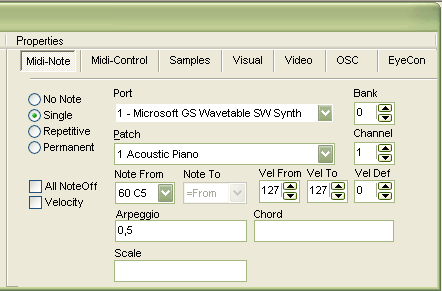| Element Editor -
Midi Output (2) |

The Port list shows all the available Midi connections on your computer. There is usually at least one, the Microsoft software synthesizer. Depending on external interfaces or installed virtual ports, there might me several more. The port selections determins where all MIDI messages for that Eyecon line or field are sent to.
Determines, which patch change message is sent before sending the actual MIDI note. The patch change selects a sound. Sounds will sound a little different on each synthesizer.
This selector allows to select alternative patch bank sets. With the patch chang you can select from up to 127 different instruments. Modern synthesizers often support more than 127 instruments. So somebody came up with the idea to have them on different 'pages' or 'banks'. To switch between banks actually a control change message is used. The bank change message is not supported by all MIDI equipment.
message to change general purpose settings. There are 127 different controller values possible, some have predefined meaning (7 = volume), most of them don't. The controller value is a number between 0..127.
Defines the Midi Note which is sent when you hit a touchline or field. If Note to is not selected, only one note is associated with the line (or field). In case you select a range of notes which are spread over the line. That means if you hit the touchline at the beginning of the line (end with a slightly bigger dot) the lowest note is played, the other end plays the other note. The notes are always spread chromatically, if you don't want that, you have to use the 'Scale' field.
Note commands are always sent with a velocity value which indicates, how hard you hit the key, if midi is generated by a keyboard. The 'from' and 'to' settings describe how velocity values are spread over the range of the line (of field). The field 'Def' determines, what happens if you leave a line (or field). Then the note is sent out again with the Default (you could also call it fallback) value. A velocity of 0 is used as a 'note off' command.
The last section on the Midi note are 3 fields which allow you to define variations of the note pitch which is output. You can type note offsets in those fields. Imagine you want to distribute the four notes of a major-7 chord along a touchline. With Note From-Note To you always get chromatic steps. So it's not the way you want. You select the base note in the Note-From field instead. Then you type the list of note offsets in the 'Scale' Field. For a major chord that would be 0 for the base note, 4, 7 and 11 for the chromatic offsets. You would type 0,4,7,11 into the Scale Field.
If you would move those numbers into the chord field, all the notes of the chord are played simulaneously.
In case you move the numbers into the arpeggio field, they are played one after the next, whenever you hit the touchline (or field) again. With the 'repetitive' mode you get a arpeggiated sequence of the selected notes.
EyeCon Help, this file last changed on 19. Jan 2006